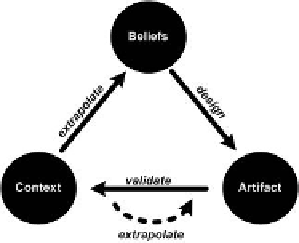Information Technology Reference
In-Depth Information
Fig. 7.1
A simplified framework of the design process, derived from (Martens, 2009b, per-
sonal communication). According to this framework, the designer forms beliefs about the
potential consequences of use of a given product in a given context, grounded on empirical
knowledge. These beliefs are in turn externalized to artifacts and the artifacts are validated
on a number of criteria that have been derived from prior beliefs, or empirical insights from
the previous design iteration.
feedback as in the experience sampling method (Hektner et al., 2007). In this way,
we were able to identify two distinct usage modes of a media recommender system,
i.e. goal-oriented interaction as in the case of searching for specific information and
action-oriented interaction as in the case of browsing through media content (Has-
senzahl, 2005).
feedback
user actions
time
(a) action context for user-initiated feedback
(b) action-based experience sampling
Fig. 7.2
Information about preceding user actions can (a) provide the context for user-
initiated feedback, and (b) trigger event-based experience sampling.
This approach enabled us in capturing momentary experiences that pertained to
interactions that we were interested in. We observed however that experience sam-
pling is often intrusive to users' interactions and can lead to loss of information as
participants often cannot interrupt the activity they are engaged in to provide sub-
jective feedback regarding their experience (see also Hsieh et al., 2008). One could
thus integrate such in-situ field feedback with methods for retrospective feedback
as in the case of iScale, or the Day Reconstruction Method (Khan et al., 2008, for
instance, see). These methods will be attempted in UXSuite (Koca and Funk, 2009),
a start-up company supported by a STW valorization grant.


















Search WWH ::

Custom Search